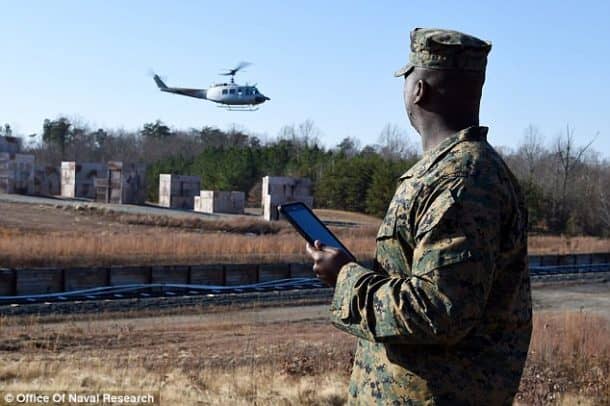US Marines will soon be dropping into battle using self-flying helicopters. The office of Naval Research (ONR) has revealed its first test of an autonomous helicopter. It is being hoped that the system will initially be used to resupply troops on the front line and later on, will be taking them to the battlefield as well.
‘This is more than just an unmanned helicopter,’ said Dr. Walter Jones, ONR executive director. ‘AACUS is an autonomy kit that can be placed on any rotary-wing platform and provide it with autonomous capability. Imagine a marine Corps unit deployed in a remote location, in rough terrain, in need of ammunition, water, batteries or even medical supplies like blood.
‘With AACUS, an unmanned helicopter takes the supplies from the base, picks out the optimal route and best landing site closest to the warfighters, lands, and returns to base once the resupply is complete – all with a single touch of a handheld tablet.’

The need for this capability surfaced during Marine Corps operation in Iran and Afghanistan, said the experts. Cargo helicopters and resupply convoys of trucks bringing fuel, food, water, ammunition and medical supplies to the front lines frequently found themselves under fire from adversaries or the target of roadside bombs and other improvised explosive devices.
AACUS is designed for simple use. A single operator with minimal training can call up the supplies needed and order the flights using only an intuitive handheld tablet. During the Dec, 13 demonstration tests at Quantico, a marine with no prior experience with the technology was given a handheld device and 15 minutes of training. The Marine was able to quickly and easily program in the supplies needed and the destination and the helicopter arrived quickly with the supplies. Even selecting an alternating landing site autonomously on last-second no-fly zone information was added in by the Marine.
The demonstration featured a UH-1 ‘Huey’ flying autonomously on multiple missions. “We’ve developed this great capability ahead of requirements and it’s up to us to determine how to use it,” said Lt. Gen. Robert Walsh, commanding general, Marine Corps Combat Development Command.
The young Marines today have grown up in a tech-savvy society which is also an advantage with the addition of such technologies. “We have got to keep pushing and moving this technology forward.” Officials say AACUS represents a leap-ahead technology for the Marine Corps and Navy, moving unmanned flights far beyond the current standard, which requires a specialized operator to select a landing site and manually control an unmanned aircraft via remote.
‘AACUS give the revolutionary capability to our fleet and force,’ said Dennis Baker, AACUS program manager. ‘It can be used as a pilot aid to operate in GPS and communications-denied arenas or allow fully autonomous flights in contested environments. This will keep our pilots and crew out of harm’s way.’


